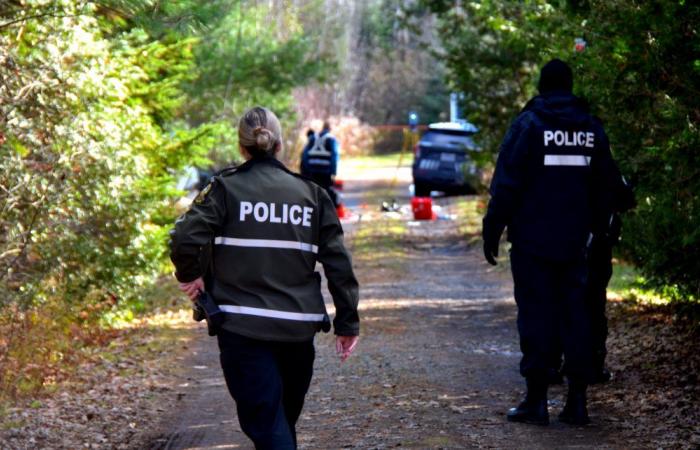The examination of the investigation report prepared by the BEI was entrusted to a criminal and penal prosecutor (prosecutor). The latter carried out a complete examination of the evidence in order to assess whether, in light of the evidence retained, it reveals the commission of criminal offenses. The prosecutor met and informed the relatives of the deceased of the reasons for the decision.
As reported the Twenty55 during the events that occurred on November 7, 2023, At around 1:30 a.m., a man was arrested by SQ officers in the Drummondville area for assaulting police officers. He was then released on a promise and returned home. Around 3:30 p.m. that same day, the man contacted a relative to come pick him up, which he did in his van. When he arrived, the relative noticed that the man was intoxicated.
The DPCP specifies in the analysis that, around 5:31 p.m., they arrived at the relative’s residence and a conflict broke out between the two men. The man becomes disorganized, pours a beer over the relative’s head, kicks, punches and screams incoherently. He continues to hit his loved one, even when he falls to the ground. The man films the scene with the relative’s cell phone, opens a drawer and takes the relative’s wallet as well as an approximately four-inch pocketknife-style knife. The relative left the home to go to his neighbor’s house and contacted 911 around 6:43 p.m., due to the man’s behavior.
At around 7:12 p.m., three patrol vehicles, with a total of five police officers on board, arrived on the scene. At a distance from the residence, the police officers prepared to intervene. They then heard the man trying to start the relative’s van. Given that the relative’s residence was located in a dead-end street, the police officers placed hollow-tipped spikes on the road to try to limit a potential escape. However, they removed them within minutes, believing that due to the man’s intoxication, he might attempt a dangerous manoeuvre.
At 7:26 p.m., the police again heard the sound of the van’s engine. They then board their respective vehicles to locate the man. Only the headlights of patrol vehicles light the way. The lead vehicle turns left onto the path leading to the residence followed by the other vehicles. The path is narrow, barely the width of the vehicles, and it is bordered on one side by a ditch and on the other by a forest.
The police officers heard the sound of an engine again, this time coming closer and followed by a “bang”. At high speed, the rear of the van drove into the lead vehicle. The van then ended up in the ditch at the side of the road, with the front of the vehicle pointing towards it.
The man presses the accelerator of the van, presumably to get out of the ditch. The noise caused by the maneuver is deafening and complicates communication between the police officers. The latter get out of their vehicles and ask the man to “put his hands up” and turn off the van, without success. The officer involved notices that his colleagues are pointing their electrical discharge weapons (EDWs) at the man, but that they cannot use them, since the windows of the van are closed. He also notices that all four wheels of the van are in contact with the ground.
The officer involved then notices that the man is rocking back and forth trying to free the van while continuing to press the accelerator and that the van is about to pull out of the ditch, the wheels starting to rise. wall of the ditch, while police officers were on the road less than two meters from the hood of the van. He tries to warn his colleagues, without success due to the noise, and he fires the first shot. The bullet went through the front passenger side window and struck the man. The window cracks, but does not break. The man stops rocking, but continues to press the accelerator. The police repeatedly shout at the man to “put your hands up”, still without success.
At the same time, one of the officers approached the cracked window on the front passenger side with his telescopic baton, intending to smash it so that the EWDs could be used. As he stood near the window and reached out, the man became agitated again and the officer involved saw him making a gun sign with his hand and leaning into the van toward the foot of the passenger seat. When he stood up, the officer involved saw that the man was holding an orange chainsaw and was making a gesture to brandish it at the officer standing near the passenger side window. The officer involved tried to warn his colleague by yelling the information, again without success. At this point, he decided to fire two shots. The window broke and the man stopped moving.
At 7:28 p.m., the officer involved called an ambulance.
The police then noticed that the man was unconscious and after securing the scene, they took him out of the van, laid him down on the road, searched him summarily and seized the knife. They then begin resuscitation maneuvers and use the automated external defibrillator. At 8:12 p.m., the ambulance arrived on scene and left with the man at 8:13 p.m. He was pronounced dead at 8:56 p.m.
In this case, the DPCP is of the opinion that the conditions listed in sections 25(1) and 25(3) of the Criminal Code are met.
Section 25(1) provides protection to a peace officer using force in the administration or enforcement of the law, provided that he acts on reasonable grounds and uses only as much force as is necessary in the circumstances.
This may include, in particular, a legal arrest, or even maneuvers aimed at disarming a person or controlling a person in crisis, because of the risk they represent for themselves or for others.
Section 25(3) states that a police officer may, acting on reasonable grounds, use force likely to cause death or grievous bodily harm if he or she believes it is necessary, in order to protect or protect the people under its protection against such consequences.
The police, being peace officers, are therefore authorized to use force which, in the circumstances, is reasonable and necessary to carry out their duties and which is not excessive.
The courts have established that the assessment of force should not, however, be based on a standard of perfection.
Indeed, police officers are often placed in situations where they must make difficult decisions quickly. In this context, they cannot be expected to measure the degree of force applied accurately.
In this case, the intervention of the police officers was legal and was based on their duty to ensure the safety and lives of people. Considering the immediate danger the officers faced from the likelihood that the van would re-enter the path and strike them, as well as the likelihood that the man would use the chain saw on a police officer, the man’s failure to comply to the orders given on numerous occasions, the impossibility of using the AIE in the circumstances as well as the noise of the engine which made communication between the police officers impossible, the police officer involved had reasonable grounds to consider that the force applied to the man’s location was necessary for their protection from serious bodily harm or death.
Consequently, the DPCP is of the opinion that the use of force by the police officer was justified under sections 25(1) and 25(3) of the Criminal Code. Analysis of the evidence does not reveal, in his opinion, the commission of a criminal offense by the SQ police officer involved in this event.






